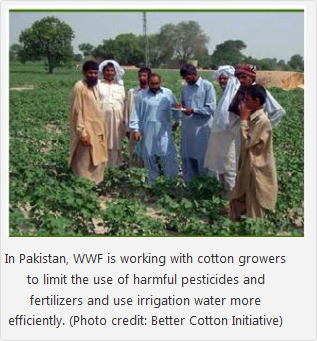Ninety percent of the world’s cotton is grown by farmers in developing countries – they sell their cotton to local spinners and ginners that supply large international buyers, such as Hanes, Victoria’s Secret, and Nike.

But, cotton cultivation can have severe health risks for those who grow it—and the environment. Inefficient irrigation techniques make cotton one of the most water-intensive crops, and improper use of fertilizers and pesticides can threaten human health, pollute water resources, and reduce soil fertility. In Pakistan, the world’s fourth largest cotton producer, 100 percent of cotton crops are irrigated, using precious and costly water resources. And cotton grows account for 75 percent of the agricultural sector’s pesticide use in the country.
The Better Cotton Initiative (BCI)– an international membership association made up of cotton retailers, producers, and non-profit groups – is working in Pakistan, India, Brazil, and West & Central Africa (Benin, Senegal, Mali, Burkina Faso) to promote sustainable cotton cultivation that is less damaging to the health of farmers and the environment.
In Pakistan, WWF, BCI’s implementing partner, collaborates with local farmers’ associations, such as the Kissan Welfare Association to organize training workshops called Farmer Field Schools (FFS). Farmers meet once a week to share knowledge on ways to limit the use of chemical pesticides and fertilizers and use irrigation water more efficiently.
At the FFS, farmers, and especially women farmers, are learning to protect themselves from the harmful effects of pesticides. Zohra Bibi, who is married to a cotton farmer in the south Punjab region says, “We used to suffer from skin problems, such as rashes, as well as dizziness and headaches. We would use the same dirty hands for cooking after we had come in from the fields and sometimes we would even use the empty pesticide bottles in our kitchens to store wheat. Now we know better.”
Cotton farmers in the region now also test their soils at a laboratory, a process that costs Rs.2 or USD 0.02. These tests show farmers when and how much fertilizer and pesticide to use and also helps them use water more efficiently. They used to spray their fields up to 12 times, but this is now down to three or four times per season. And while farmers used to irrigate their fields up to 10 times, they are limiting this to 4 times each season. Farmers are also encouraged to introduce natural fertilizers like farmyard manure in their cotton fields.
“Using integrated pest management we reduced the overall use of pesticide and fertilizer. We even used less water, with no impact on the yield. From 25,000 hectares they are now growing on 400,000 hectares. Over 40,000 farmers are now involved,” explained Hammad Naqi Khan Director of Programs at WWF-Pakistan at last year’s World Water Week events in Stockholm.
The FFS allows farmers to learn from each other and to build a network of support. As farmer Ghauri explains, “We all had this fragmented knowledge that we shared once we got together. Our survival lies in our unity”.
And BCI is supporting their efforts by working to create demand for Better Cotton on the global market. By 2013, the initiative hopes that Better Cotton will make up at least 15 percent of the world’s cotton supply. BCI currently counts brands like H&M, IKEA, and Levi Strauss & Co among its partners. As more brands follow suit, they will provide the momentum for change, promoting better livelihoods for small-scale cotton growers in Pakistan and across the world.

Danielle Nierenberg, an expert on livestock and sustainability, currently serves as Project Director of State of World 2011 for the Worldwatch Institute, a Washington, DC-based environmental think tank. Her knowledge of factory farming and its global spread and sustainable agriculture has been cited widely in the New York Times Magazine, the International Herald Tribune, the Washington Post, and
other publications.
Danielle worked for two years as a Peace Corps volunteer in the Dominican Republic. She is currently traveling across Africa looking at innovations that are working to alleviate hunger and poverty and blogging everyday at Worldwatch Institute’s Nourishing the Planet. She has a regular column with the Mail & Guardian, the Kansas City Star, and the Huffington Post and her writing was been featured in newspapers across Africa including the Cape Town Argus, the Zambia Daily Mail, Coast Week (Kenya), and other African publications. She holds an M.S. in agriculture, food, and environment from Tufts University and a B.A. in environmental policy from Monmouth College.








